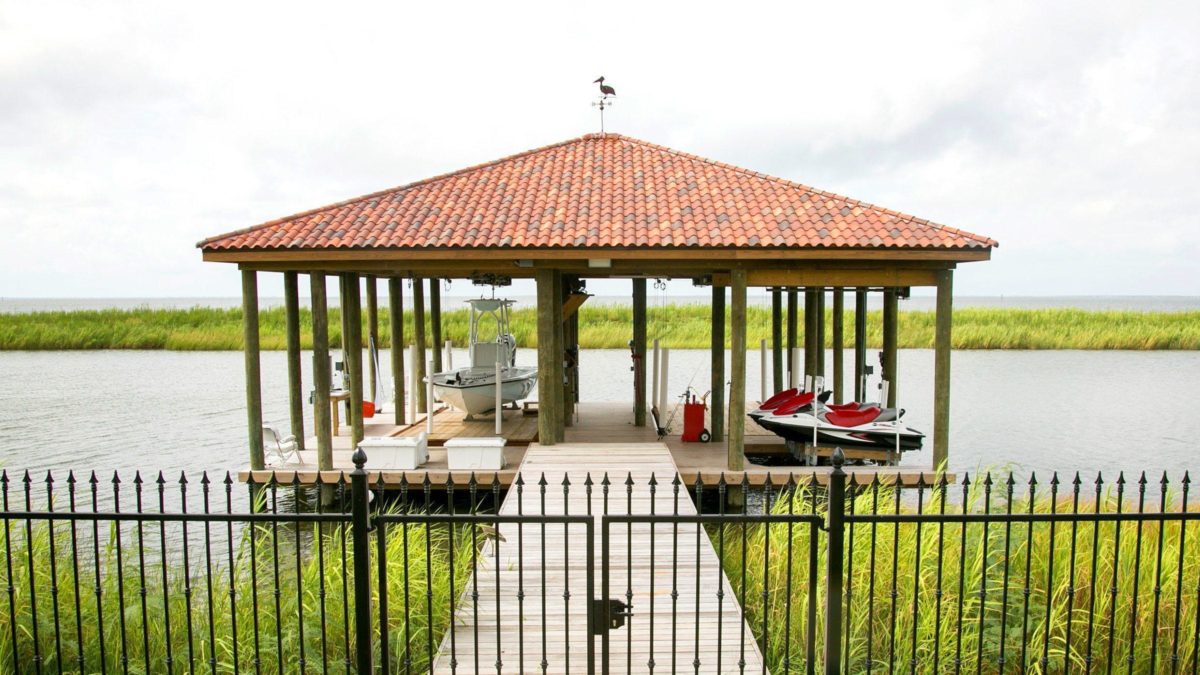This is a question we are asked every day at Lamulle Construction. There are many configurations and many are custom designed by us to meet the customer’s needs. To understand the cost we have to break down the different components that make up the boathouse and explain the costs associated with each design element. There are a lot of questions that you must answer for yourself as we discuss the different configurations and the things to watch out for. So, let’s get started.
What is a Boathouse?
A boathouse is designed to fully cover a boat and typically has a lift installed to raise the boat out of the water when not in use.
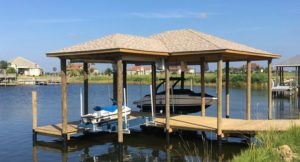 Accessing the Boat
Accessing the Boat
The first consideration in the design is how you will access the boat in the boathouse.
• Position to Shore
• Will it be positioned parallel to the shore against a bulkhead or will it be perpendicular to the shore?
• If it is parallel to the shore, will you be stepping off the land directly onto the boat?
• Is there enough water depth to allow the boat to float next to the bulkhead?
• Deck Access
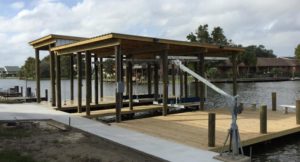 If you need to have the boat out farther away from the bulkhead for water depth purposes, you may want to install a small deck area between the bulkhead and the boathouse. This might give you access to deeper water if the water bottom drops off quickly. This deck area will increase the total square feet of decking necessary to install your boathouse. If your boathouse is positioned perpendicular to the shore, then you will need decking on one or both sides of the boat slip to access the boat. Space and choice of decking materials will be the two considerations to the cost of the deck area.
If you need to have the boat out farther away from the bulkhead for water depth purposes, you may want to install a small deck area between the bulkhead and the boathouse. This might give you access to deeper water if the water bottom drops off quickly. This deck area will increase the total square feet of decking necessary to install your boathouse. If your boathouse is positioned perpendicular to the shore, then you will need decking on one or both sides of the boat slip to access the boat. Space and choice of decking materials will be the two considerations to the cost of the deck area.
• Size of Deck
People buy waterfront property because they have a connection with the water. They may enjoy the view, water sports, or fishing. In any case, the deck area of your boathouse is also the leisure area of your boathouse. How much space do you want? If you plan to spend time out by the water, other than just getting on/off your boat, then you might consider some covered deck area to give you a greater “connection” to the water. If you are just fishing and washing your boat, you do not need a ton of deck space. If you are hanging out by the water or having a crawfish boil, then you might want more.
• Decking material will determine the cost per square foot.
• Treated wood 2×6 decking material is the least expensive choice of decking and the cost ranges from $16-$20/sqft depending on the total area and shape of the deck. Treated wood decking exposed to sun will last 7-10 years, longer if protected from the sun and rain.
• Composite decking, such as Azek, will last longer, require less maintenance, and maintain a better appearance. Its typical life span is 15-25 years in most cases, especially under a roof. But composite decking, which is not a ridged material and requires more joists installed for support, is much more expensive, ranging from $28-$32/sqft depending on specific material chosen and total area installed.
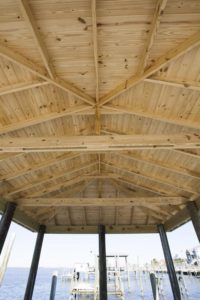 Roof of Boathouse
Roof of Boathouse
The next consideration is the roof style and type of roofing material. The roof is the single most expensive component of a boathouse. There are three basic styles of roofs that we commonly install on boathouses. Check with your home owner’s association for any restrictions that might apply.
• Hip Roof: First is the hip roof. This is a very common type of roof system installed on homes and consists of wooden rafters that rise on 4 sides together to form a peak. This is the most common type of roof we install as it most directly matches the residence the boathouse is built behind. Hip roofs can range from $12-$18/sqft depending on variation of roof design and decking choices. This is a great roof and meets most codes for wind resistance. If the final roof material will be metal, then there are two choices you can make on how this metal is installed on the rafters.
• The cheapest way to install the metal is to nail down wood stripping across the rafters that the metal is screwed down to.
• The next option is to deck the rafters with either oriented strand board plywood (OSB) or tongue and groove 2×6 lumber. Decking the roof before the final material is installed makes for a stronger roof system that is one solid unit. This system will exceed most building codes for wind resistance. Tongue and groove 2×6 decking is 1.5” thick and is installed when the customer wants a more appealing look to their boathouse. If you plan to entertain guests or sit on the deck at your boathouse and watch the sunset, this might be a great option for you. It is also incredibly strong and exceeds the 140mph rating.
• At Lamulle Construction we prefer to deck the roof prior to metal installation. This will meet or exceed the 140mph wind load rating required for our service area.
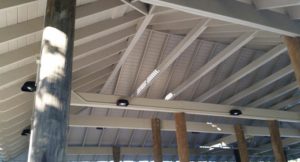 • Gable Roof: Second roof type is the gable roof, which consists of wooden rafters forming two sides which meet to form a peak in the middle. This roof abruptly terminates on each end of the boathouse and can be either left open or closed in with siding. Again, with this style of roof, the rafters can either be decked or stripped if metal R-panel will be applied. If the end is left open, this is a weaker type of roof installed in areas less prone to high winds. In high wind areas, the cable is most often closed with siding to prevent the wind from generating uplift on the roofing materials, stripping it away. If shingles are to be installed, the rafters must be decked so the shingles can be nailed to the decked surface. Lamulle Construction does not recommend an open gable design if the boathouse will be in the open coastal areas where trees cannot break up the wind to some degree. The cost of gable roofs is like that of hip roofs, ranging from $18-$28/sqft.
• Gable Roof: Second roof type is the gable roof, which consists of wooden rafters forming two sides which meet to form a peak in the middle. This roof abruptly terminates on each end of the boathouse and can be either left open or closed in with siding. Again, with this style of roof, the rafters can either be decked or stripped if metal R-panel will be applied. If the end is left open, this is a weaker type of roof installed in areas less prone to high winds. In high wind areas, the cable is most often closed with siding to prevent the wind from generating uplift on the roofing materials, stripping it away. If shingles are to be installed, the rafters must be decked so the shingles can be nailed to the decked surface. Lamulle Construction does not recommend an open gable design if the boathouse will be in the open coastal areas where trees cannot break up the wind to some degree. The cost of gable roofs is like that of hip roofs, ranging from $18-$28/sqft.
•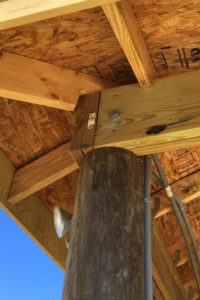 Flat Roof: The third roof system is the flat roof which had no peak and only has a slight slope to the roof allowing the rain to shed. The flat roof is always made from metal roofing material called R-panel, never shingles. The metal R-panel is screwed down into wood purlins which are nailed down to joist which span across the boat slip. This is a weak roof system which cannot achieve the wind rating of hip roofs. But the low cost of the roof and easy construction of the flat roof, makes replacement of the roof easy should it be damage by storms. These roofs are typically only installed at fishing camp areas and not allowed in most subdivisions. Check your homeowner’s association to see if flat roofs are allowed in your area. Flat roofs typically range from $9-$11/sqft. depending on the size of roof (the larger the roof, the lower the cost).
Flat Roof: The third roof system is the flat roof which had no peak and only has a slight slope to the roof allowing the rain to shed. The flat roof is always made from metal roofing material called R-panel, never shingles. The metal R-panel is screwed down into wood purlins which are nailed down to joist which span across the boat slip. This is a weak roof system which cannot achieve the wind rating of hip roofs. But the low cost of the roof and easy construction of the flat roof, makes replacement of the roof easy should it be damage by storms. These roofs are typically only installed at fishing camp areas and not allowed in most subdivisions. Check your homeowner’s association to see if flat roofs are allowed in your area. Flat roofs typically range from $9-$11/sqft. depending on the size of roof (the larger the roof, the lower the cost).
Boat Lift
The next item for cost consideration is the boat lift. They come in many styles, materials, and weight capacities. Please refer to our article on boat lift choices for an explanation of these details. The cost of a boat lift will range from $6,000-$16,000 for a 6,000LB lift which will accommodate most center console bay boats under 30ft in length. Please contact Lamulle Construction to size the boat lift to your particular boat.
Pilings
The final component of the boathouse is the actual pilings that the boathouse sits on. Pilings are chosen for your project based on the following considerations: water depth, water type, size of boat, and composition of water bottom. This can be complicated so let’s ask a few questions:
• Do you have salt water? Then you need 2.5 CCA treated piles to resist wood boring marine animals.
• If you have freshwater, then you can go with .80 CCA treated piles.
• If your water is brackish, then we would recommend going with the 2.5 CCA piles.
• Next, how deep is the water?
• If it is shallow, 3-5ft, and the water bottom is hard clay, you might be able to go with 30 foot piles.
• If the water is deeper, 6-10ft, or the water bottom is silty or sandy, then you would be better with 40 foot piles for extra stability.
• If the water is very deep, 15+ feet OR the water bottom is very soft and loose, then you will most likely need 50 foot or greater piles.
• The cost of pilings is $13/ft for .80CCA piles and $16/ft for 2.5CCA piles up to 40ft in length. Piles larger than 40ft are special order and require us to check with our supplier. The size and shape of the boathouse will determine how many piles you will need to support the boathouse.
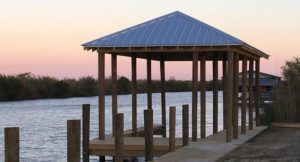
Now that you know all the variables that go into figuring out the cost of a boathouse, let me give you a rough idea of what a typical cost range is.
For a single boat slip boathouse with a shingled hip roof, the cost will range from $25-$30K depending on how much deck you add and boat lift. For a boathouse with two slips and a decent size deck down the middle, the range will be $60-$70K. Again, it depends a lot on what you choose for options. These ranges are just for budget purposes and can be higher or lower depending on your choices. Boathouses are often custom designed and can be difficult to determine the cost. I have seen flat roof single boathouse cost only $16,000. We hope that we shed some light on this topic for you and we hope you will contact us with any questions you may have.




